Last updated on July 4th, 2024 at 11:30 pm
The Feather and Fan crochet stitch pattern is a combination of simple stitches that create a beautiful wave-like effect. It is a mesmerizing pattern that adds a touch of timeless charm to your projects.
Crochet enthusiasts, if you’re on the lookout for a stitch pattern that effortlessly combines elegance with simplicity, you’re in for a treat. A great stitch with that wow factor.
If you like chevron patterns, this is another. With the look of soft ocean waves.
Bucket List Crochet Project
For years, I have adored this gorgeous stitch pattern from afar. It is so beautiful and dreamy with soft, wavy lines. To me, it has always looked hard to do. I put it on my bucket list and recently, I decided to tackle learning this stitch.
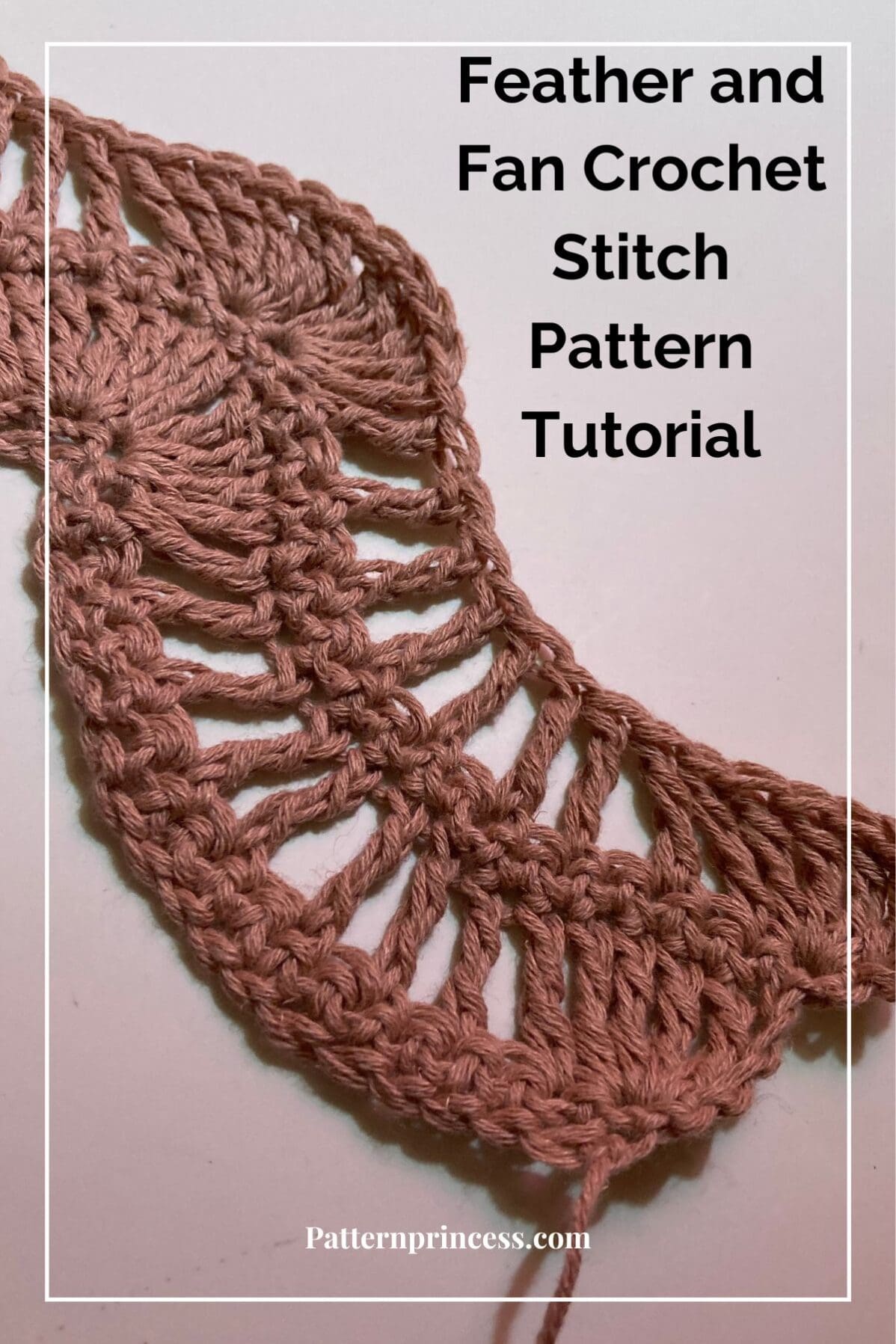
Post contains affiliate links, and we earn commissions if you shop through the links on this page. For more information, please read the disclosure section under the About Us page.
Well, I am here to tell you, it is way easier than you may think. I urge you to give this one a try. Now that I know how to make it, you will see a few more projects using this feather and fan stitch.
Right now, I am working on an amazingly easy and exquisite scarf that you can wear confidently to all your Holiday parties or shopping or at the beach. It is truly that versatile.
For now, let’s work on helping you learn this stitch.
Written Pattern, Photo Tutorial, and Video Tutorial for the Crochet Stitches
The pattern includes both a written pattern, photo tutorial, and a video tutorial to walk you through each step!
By the end of this free pattern tutorial, you’ll be well on your way to creating stunning, wavelike patterns. They are sure to captivate both your heart and the eyes of those who behold your handcrafted creations.

How do you crochet a feather and fan stitch?
Crocheting the feather and fan stitch is rather easy. Once you get going, this pattern is a repeat of rows 2 and 3, which makes the repetition simple to follow.
When working row 2, you are working treble crochet stitches making the soft peaks and valleys. Row 3 is simply single crochet stitches across.
Pattern Variations
It seems that just like a chevron, there are several different ways you can work the stitches and the peaks and valleys. I just want to take a moment to both offer you some ideas on changes you could make. Along with letting you know that this pattern may not match another one due to these differences.
Double Crochet Versus Treble Crochet. This pattern uses the treble crochet stitch; however, I have seen this pattern completed using the double crochet stitch.
Placement of Stitches. Another variation is where the stitches are worked. When working the single crochet row, I worked through both loops on the top of the stitch. Other patterns have sometimes worked in just the front loop or back loop. This will create a ridge, which adds a lovely texture.
Number of Stitches for the Valleys. You may see other patterns with a different number of stitches for the valleys, as in 6, 7, and 8. This pattern uses a total of 9 stitches for the valley.
Double Crochet Versus Single Crochet. One last variation is the third row being worked in a double crochet versus the single crochet stitch. If you choose to do that, it’s okay. The result of what you are looking to achieve is up to you.

What yarn would work well with the feather and fan crochet stitch?
The choice of yarn for the Feather and Fan crochet stitch largely depends on the type of project you’re working on and the desired outcome. Here are some yarn options that work well with this stitch pattern:
It’s a beautiful lace stitch that works well with just about any yarn.
Yarn Weights
Lace Weight Yarn. Lace weight yarns, which are very fine and delicate, are an excellent choice for creating lightweight and airy projects like lacy shawls, wraps, or delicate doilies. They highlight the openwork of the stitch beautifully.
Fingering Weight Yarn. Fingering weight yarns are slightly thicker than lace weight and are suitable for lightweight yet slightly warmer projects. They work well for shawls, lightweight scarves, and summer tops.
Sport Weight Yarn. Sport weight yarn is a bit thicker than fingering weight and provides a good balance between drape and warmth. It’s ideal for creating lightweight garments like cardigans, baby blankets, and summer sweaters.
DK (Double Knit) Weight Yarn. DK weight yarns are even thicker and can add more substance to your projects. They are great for making cozy yet not too heavy blankets, wraps, and winter accessories.
Worsted Weight Yarn. Worsted weight yarns are versatile and can be used for a wide range of projects. When used with the Feather and Fan stitch, they produce warm and cozy items like scarves, cowls, and blankets.
Bulky and Super Bulky Yarns. If you want a quick and chunky project, consider using bulky or super bulky yarns. These will produce thick, warm, and textured items such as winter scarves, blankets, and even oversized sweaters.
Types of Yarn
Variegated and Self-Striping Yarns. To add visual interest to your Feather and Fan projects, consider using variegated or self-striping yarns. These yarns create beautiful color patterns within the stitch pattern without the need for color changes.
Cotton Yarn and Cotton Blends. If you’re making items like dishcloths, table runners, or lightweight summer tops, cotton yarns are an excellent choice. They provide breathability and durability, perfect for warm-weather projects.
Silk Yarn. For a touch of luxury and sheen, silk yarns can make your Feather and Fan projects stand out. They are perfect for special occasion shawls or wraps.
Ultimately, the choice of yarn depends on your project’s purpose, the season, and your personal preferences. Experiment with different yarn weights and fiber compositions to achieve the desired look and feel for your Feather and Fan crochet creations.
If you would like to make a gorgeous shawl using this feather and fan stitch, we just posted a free crochet pattern for one. The Abigail Crochet Sideways Shawl.
Here are step-by-step directions to crochet the Feather and Fan stitch.
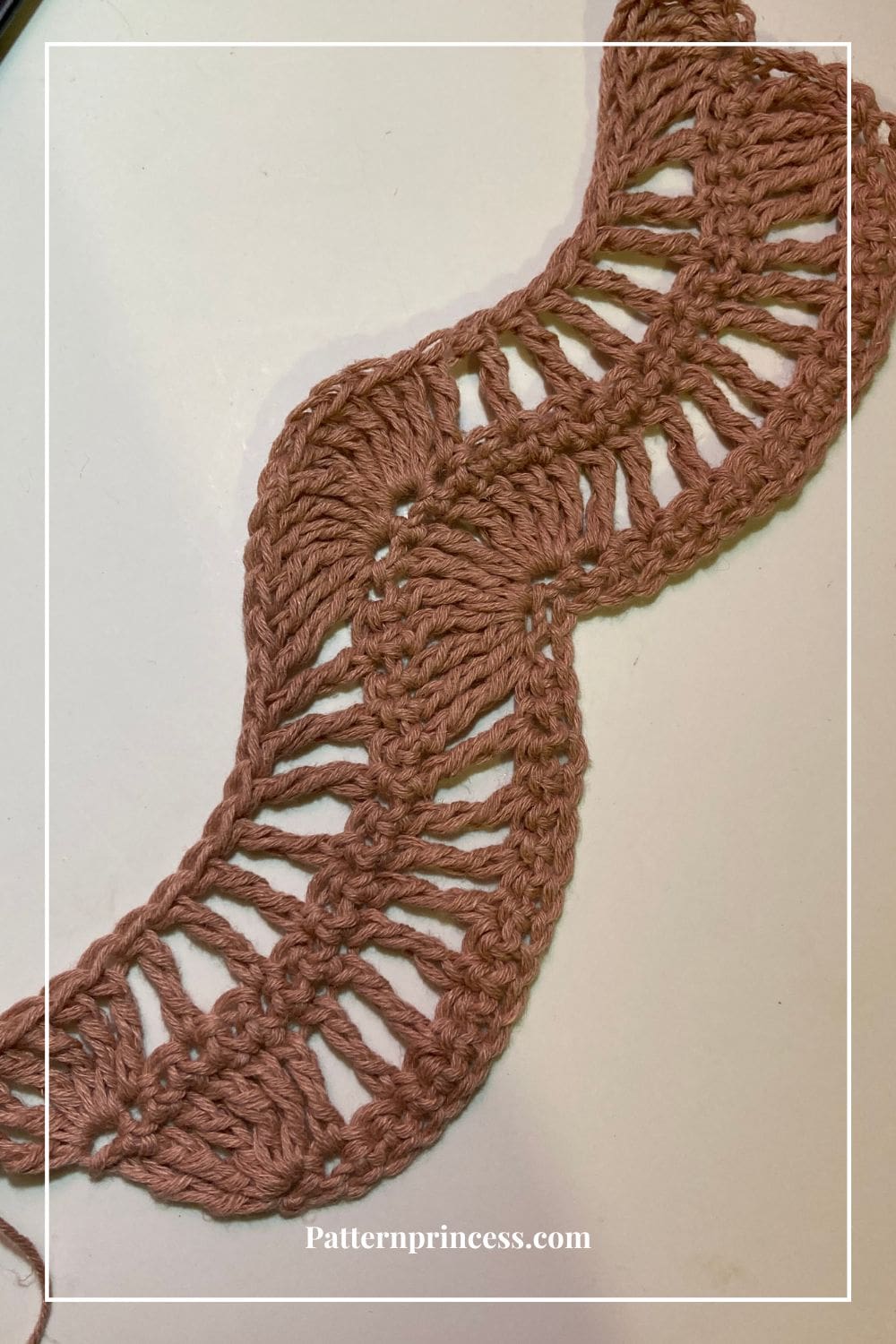
Directions: Feather and Fan Crochet Stitch Pattern Tutorial
Skill Level
Advanced Beginner or Intermediate.
You should be able to work the treble crochet stitch and single crochet stitch.
Gauge
The gauge will depend on what weight yarn you choose along with the crochet hook size.
Size
The size of your project will depend on your starting chain.
Change the width by adding or increasing the beginning chain stitches. The pattern repeat for this project is a multiple of 19 plus 20. That means that a minimum chain needs to be at least 39 stitches.
Change the length by adding or decreasing the rows.
Materials Needed
Yarn of your choice
Appropriate crochet hook for your yarn
Yarn needle for weaving in ends
Scissors for cutting off yarn
Abbreviations
CH = Chain
SC = Single Crochet
SK = Skip
ST = Stitch
STs = Stitches
TR = Treble Crochet
[ ] = Repeat Between
Special Stitches Used
Treble Crochet Stitch
A treble crochet, also referred to as the triple crochet stitch is taller than a double crochet.
To make the Treble Crochet Stitch. Yarn over twice, insert the hook through both loops and pull up a loop. Next, yarn over and pull through two loops on the hook. Yarn over again and pull through the next two loops. Lastly, yarn over again and pull through the last two loops on the hook.
You can find more free crochet tutorials and special crochet stitches.
Pattern Notes
Turn at the end of each row.
The chain four at the beginning of row 2 and every other row after counts as a treble crochet.
Chain 1 for the single crochet rows does not count as a stitch.
Keep your stitches loose. Make sure to place your last stitch in the top stitch of the previous row turning chain. This helps make the sides very straight.
This pattern is written in U S Crochet Terms.
Since you will be skipping stitches in row 2, it is nice to have the single crochet worked in each stitch in the first row. This helps the beginning look just like the last row.
Instructions
Start with a Foundation Chain
To begin, chain a multiple of 19 stitches plus 20 additional chains. The sample size is 39 chains.
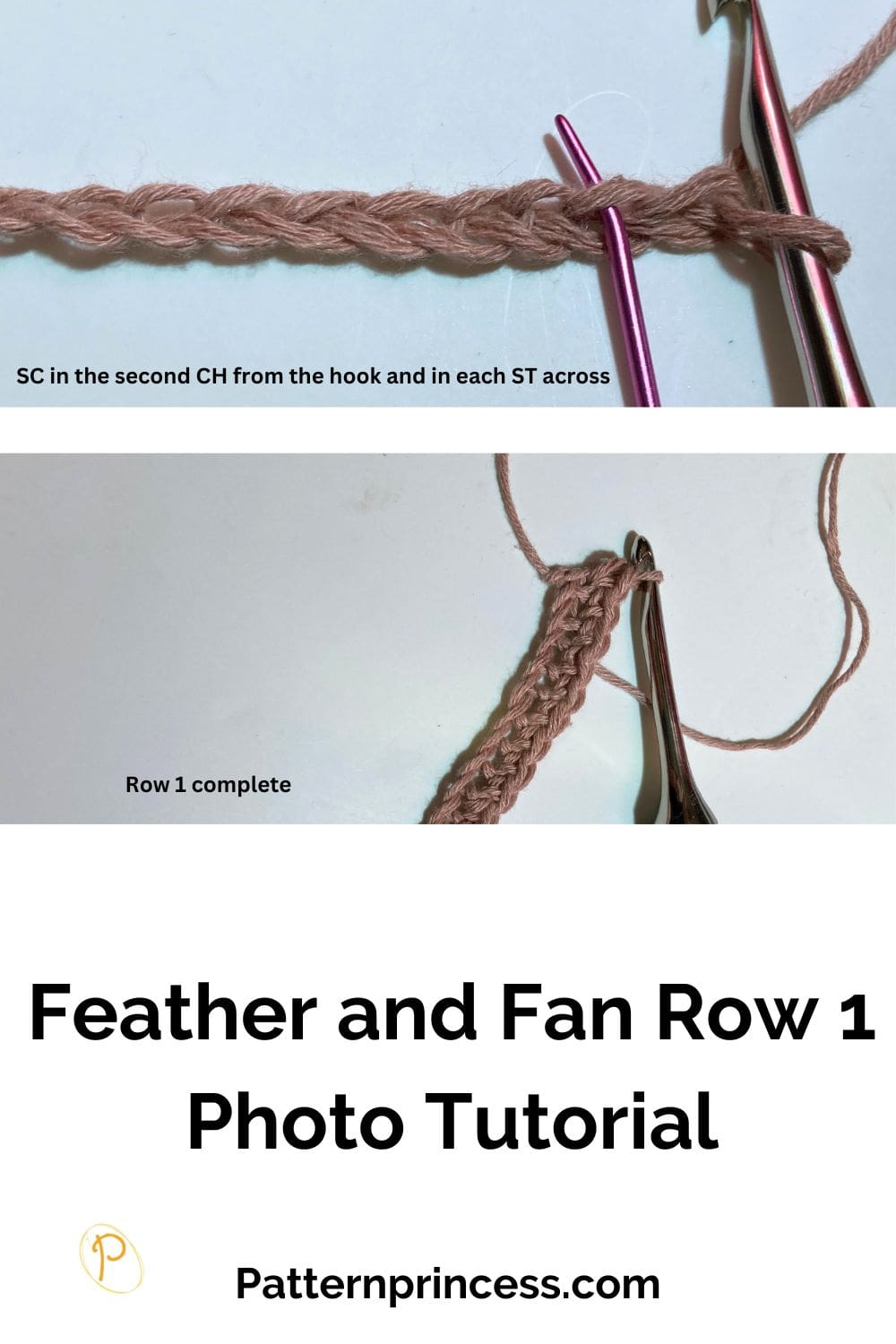
Row 1
SC in the second CH from the hook and in each ST across. Turn

Row 2
CH 4 (Counts as a Treble Crochet here and throughout pattern). Work 4 TR in the Same ST (or 5th ST from the hook). [TR in the next ST. (SK SC, TR in the next ST). Repeat between ( ) 8 times. Work 5 TR in the next SC and another 5 TR in the next SC]. Repeat between [ ] to the last 18 SC. Work TR in the next ST. [SK SC, TR in the next ST]. Repeat between [ ] 8 times. Work 5 TR in the last SC. Turn
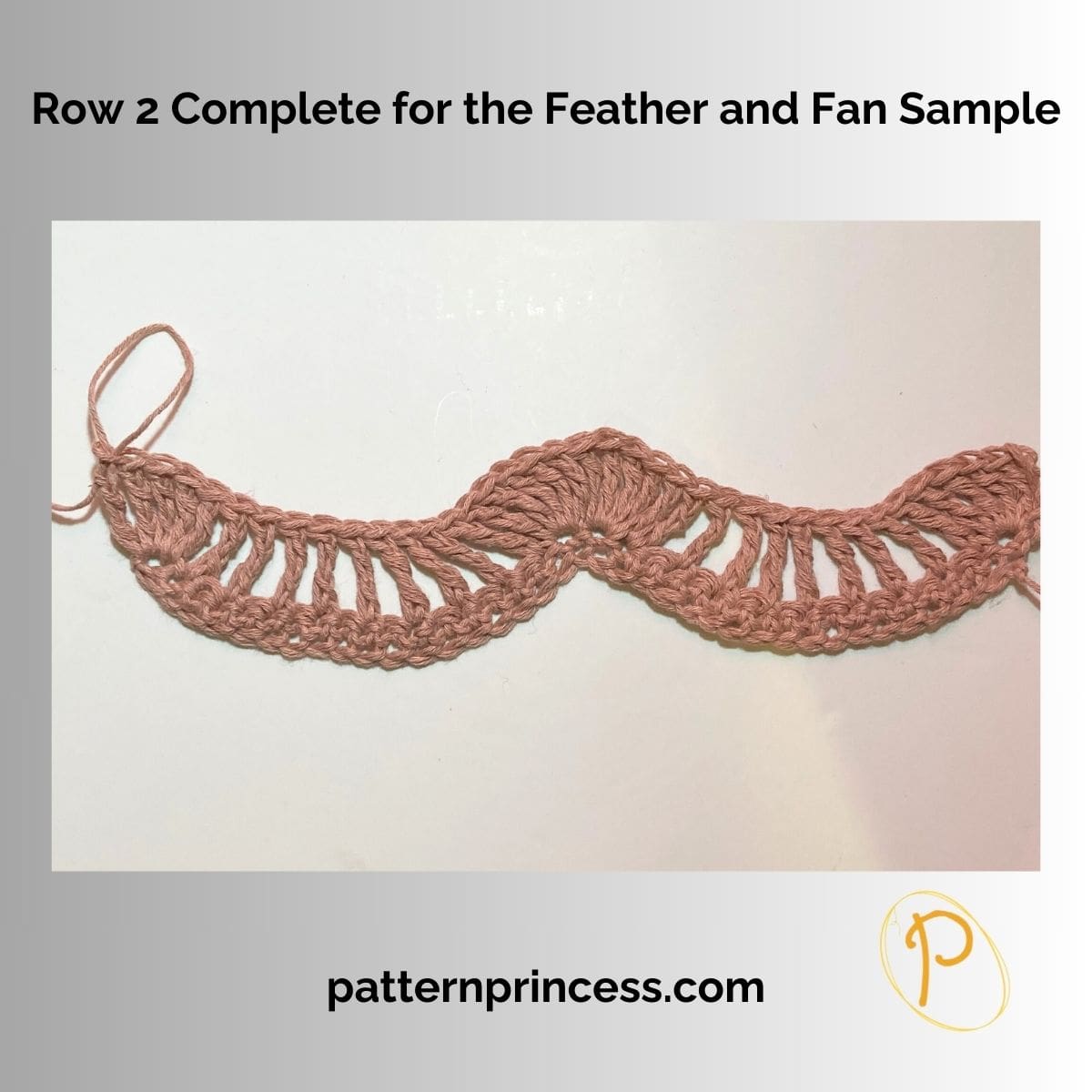
Row 3
CH 1 (Does not count as a ST). SC in the first ST and in each ST across. Turn

Rows 4 and Beyond
Continue repeating rows 2 and 3 until your project reaches the desired length.
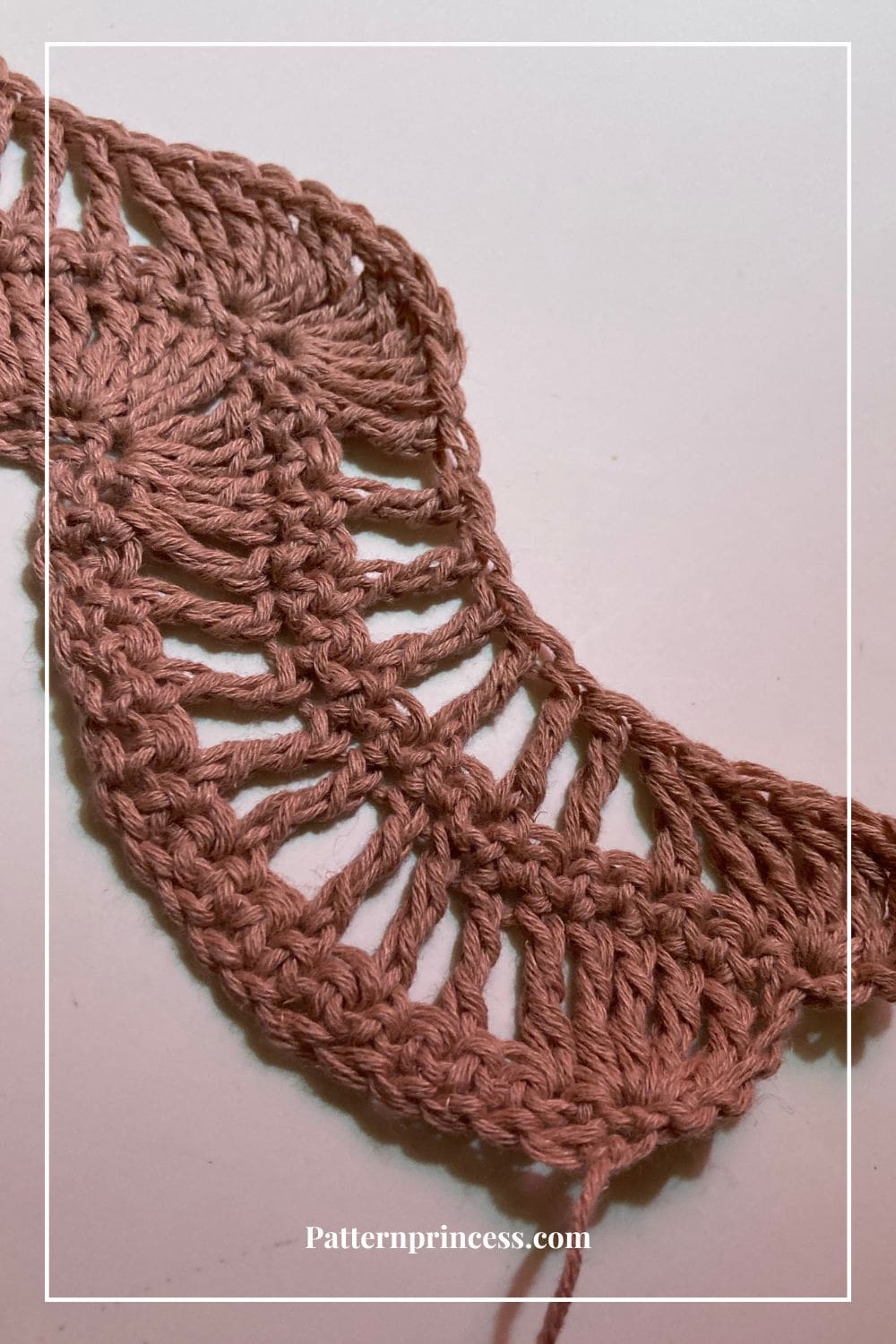
You’ll notice that as you repeat these rows, the feather and fan pattern will start to take shape.
Finishing
When you’ve reached your desired length, finish your work. Cut the yarn leaving about a 12-inch yarn tail. Pull the yarn through the last loop on the hook. Weave in any loose yarn ends with the yarn needle. Snip off any excess yarn.
Block as desired
The Feather and Fan crochet stitch pattern creates a mesmerizing ripple effect, making it perfect for creating shawls, blankets, scarves, and more.
Experiment with different yarn colors and textures to create unique and stunning projects that showcase the beauty of this classic crochet stitch. Happy crocheting.
If you love the ripple stitch or chevron look, we have a few more patterns you should check out.
Easy Ripple Baby Blanket Crochet Pattern
How to Crochet a Double Crochet Ripple Stitch
12 Point Round Ripple Baby Blanket Pattern
Easy Crochet Snood Infinity Scarf Pattern
Crochet Chevron Blanket Pattern
Video Tutorial on Our Youtube channel
Right Hand Video
Left Hand Video
Other free crochet patterns to inspire your next project.

You can find Victoria crocheting, quilting, and creating recipes. She has cooked in restaurants for over 20 years, including many larger parties. She learned to crochet when she was just 11 years old and has been crocheting ever since; over 50 years now. Over 40 years ago, she loved her first class in sewing and continues to hone her skills in quilting. Many have enjoyed the handmade gifts over the years. In her professional career, she has worked in management in a wide variety of businesses including higher education as a dean of a division. All the while attending college part-time to achieve her doctorate in higher education with an emphasis in e-learning.
